Bios 255 week 1 and 2 - Study guides, Class notes & Summaries
Looking for the best study guides, study notes and summaries about Bios 255 week 1 and 2? On this page you'll find 63 study documents about Bios 255 week 1 and 2.
Page 3 out of 63 results
Sort by
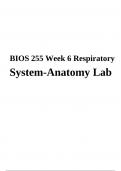
-
BIOS 255 Week 6 Respiratory System - Anatomy Lab Report (2023/2024)
- Exam (elaborations) • 6 pages • 2023
- Available in package deal
-
- $13.49
- + learn more
BIOS 255 Week 6 Respiratory System - Anatomy Lab Report (2023/2024). Respiratory Anatomy Lab Report Purpose: Please state in your own words the purpose of the lab. 1. To learn and describe the features of the respiratory tract 2. Learn in detail de cellular components of the respiratory epithelium and membrane. 3. Understand the role of the larynx in the processes of phonation. 4. Learn how Boyle's law is involve in the change of intrapleural and alveolar air pressure to help the air f...
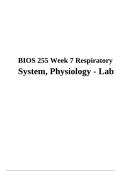
-
BIOS 255 Week 7 - Respiratory System Physiology Lab Report
- Exam (elaborations) • 6 pages • 2023
- Available in package deal
-
- $11.49
- + learn more
BIOS 255 Week 7 - Respiratory System Physiology Lab Report. Active cells require a constant supply of oxygen in order to produce energy to carry out cellular processes and release carbon dioxide as a waste product. The body must replenish this supply of oxygen and remove the build-up of carbon dioxide, as it is toxic to cells in high concentrations. The respiratory membrane provides a large surface area and a thin, permeable, and moist surface where the gaseous exchange of oxygen and carbon...

-
BIOS 255 WEEK 8 FINAL EXAM
- Exam (elaborations) • 6 pages • 2023
-
- $10.49
- + learn more
BIOS 255 WEEK 8 FINAL EXAM BIOS 255 Week 8 Cummulative Final Exam 1. Question: In general, the nervous system does each of the following, except 2. Question: What is the main difference between positive and negative feedback? 3. Question: The ankle joint (tibia + fibula with the talus) is an example of a(n) 4. Question: Characteristics of epithelia include all the following except 5. Question: Which of the following is not a property of synovial joints? 6. Question: The three types of pro...
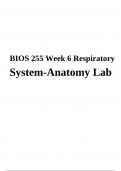
-
BIOS 255 Week 6 - Respiratory System Anatomy Lab Report
- Exam (elaborations) • 6 pages • 2023
- Available in package deal
-
- $11.99
- + learn more
BIOS 255 Week 6 - Respiratory System Anatomy Lab Report. The respiratory tract carries air to and from the lungs. Air drawn in through the nose or mouth passes through the pharynx and larynx and continues through the trachea, bronchial tree, and the lungs. Inhalation relies on decreasing the pressure in the lungs below the atmospheric pressure to draw air in. Pressure in the lungs is decreased by increasing the volume of the thoracic cavity; the lungs move with the chest wall because the ca...
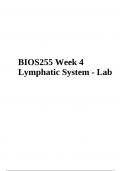
-
BIOS 255 Week 4 - Lymphatic System Lab Report
- Exam (elaborations) • 4 pages • 2023
- Available in package deal
-
- $11.49
- + learn more
BIOS 255 Week 4 - Lymphatic System Lab Report. The lymphatic system consists of lymphatic fluid, lymphatic vessels, lymphatic tissue, and lymphatic organs located throughout the tissues of the body. It functions to drain excess interstitial fluid from the tissues, to initiate an immune response against disease by producing and transporting lymphocytes, and to transport dietary lipids absorbed by the gastrointestinal tract into the blood. Lymphatic capillaries extend throughout the tissues of...
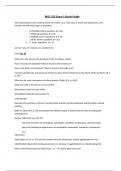
-
BIOS 255 Week 3 Exam 1 - Weeks 1 and 2 Study Guide
- Exam (elaborations) • 2 pages • 2023
-
- $24.99
- + learn more
BIOS 255 Exam 1 Study Guide This examination covers content learned in weeks 1 & 2. This exam is worth 110 total points, and includes the following types of questions: • 23 Multiple choice questions @ 3 pts • 1 Matching question @ 5 pts • 3 Multiple answer questions @ 4 pts • 1 Short answer questions @ 4 pts • 2 Essay questions @10 pts You have 75 minutes to complete the Exam Ch. 18 Ch. 19 Possible Essay Topics:
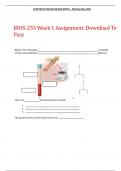
-
BIOS-255 Week 1 Assignment: Ensure Your Success by Downloading the Necessary Materials for the Course
- Other • 15 pages • 2024
-
Available in package deal
-
- $15.49
- + learn more
BIOS-255 Week 1 Assignment: Download To Pass Blood is the only liquid consisting of cells surrounded by a (plasma) There are formed elements in blood: 1. 2. 3. The plasma po rtion of the blood consists of: , , and . FUNCTIONS OF BLOOD Blood oxygen, carbon dioxide, nutrients, hormones, , and waste products. Blood homeostasis of all body fluids, , , and water content of cells. Blood against excessive loss by , and uses to protect against . FORMATION OF BLOOD CELLS ( ): is the process of producing ...
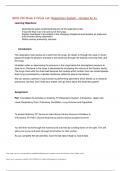
-
BIOS-255 Week 6 Virtual Lab: Respiratory System – Graded An A+
- Other • 9 pages • 2024
-
Available in package deal
-
- $12.49
- + learn more
BIOS-255 Week 6 Virtual Lab: Respiratory System – Graded An A+ Learning Objectives: • Describe the gross anatomical features of the respiratory tract. • Trace the flow of air into and out o f the lungs. • Explain how Boyle’s law relates to the changing intrapleural and alveolar air pressures and volumes during respiration. • Define various pulmonary volumes. Introduction: The respiratory tract carries air to and from the lungs. Air drawn in through the nose or mouth passes through th...
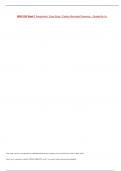
-
BIOS 255 Week 7 Assignment: Case Study I Carbon Monoxide Poisoning – Graded An A+
- Case • 3 pages • 2024
-
Available in package deal
-
- $13.99
- + learn more
BIOS 255 Week 7 Assignment: Case Study I Carbon Monoxide Poisoning – Graded An A+ 1. Carbon monoxide binds to hemoglobin more than oxygen due to its greater affinity for hemoglobin. When exposed t o Carbon monoxide oxygen cant bind to hemoglobin resulting in lack of oxygen throughout the body. 2. The pulse oximeter is a noninvasive device typically used to measure the saturation of oxygen in a patient’s blood. This is different from a CO- Oximeter which is used to measure levels of carboxyhe...
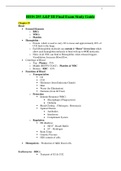
-
Chamberlain College of Nursing: BIOS 255 Final Exam (2 Versions, Latest - 2022) / BIOS255 Final Exam / BIOS 255 A & P III Final Exam: Anatomy and Physiology III with Lab |100% Correct Answers, Already Graded “A”|
- Exam (elaborations) • 50 pages • 2022
-
Available in package deal
-
- $30.49
- 1x sold
- + learn more
Chamberlain College of Nursing: BIOS 255 Final Exam (2 Versions, Latest - 2022) / BIOS255 Final Exam / BIOS 255 A & P III Final Exam: Anatomy and Physiology III with Lab |100% Correct Answers, Already Graded “A”| Chamberlain College of Nursing: BIOS 255 Week 8 Final Exam (2 Versions, Latest - 2022) / BIOS255 Week 8 Final Exam/ BIOS255 A & P III Final Exam: Anatomy and Physiology III with Lab |100% Correct Answers, Already Graded “A”| BIOS 255 Final Exam / BIOS255 Final Exam (Latest):...

How much did you already spend on Stuvia? Imagine there are plenty more of you out there paying for study notes, but this time YOU are the seller. Ka-ching! Discover all about earning on Stuvia


